We spent a bunch of time earlier this week covering the Webley-Fosbery “automatic revolver”, and I would like to close out the week with another pistol of that type, but one that’s even weirder than the Fosbery. I don’t have much information on this piece, but did find some surprisingly good photos that were originally in a Norwegian magazine. Pretty much everything I know about it comes from the captions in the pictures, which you’ll see if you read Norwegian or translate them.
Anyway, this is a design patented in 1899 by a fellow named Halvard Landstad, who lived in Kristiana (now called Oslo) at the time. He designed the gun on his own dime, and presented it to military trials in 1901, which it failed miserably.
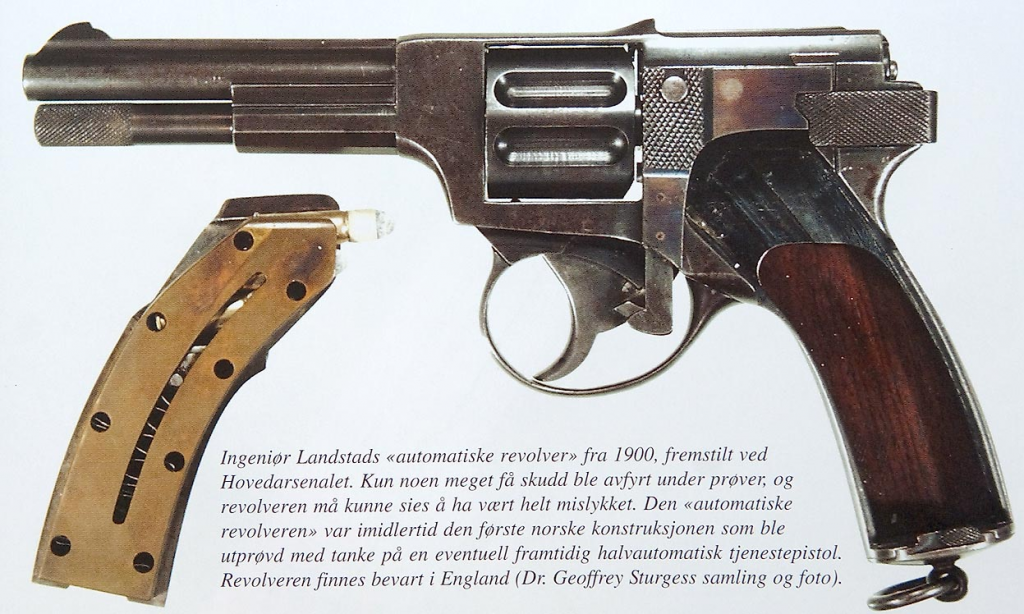
What makes this design really unusual is that it uses both a revolving cylinder and a box magazine (a bit like a Dardick, actually). The magazine – which doubled as the left grip panel – held six rounds of 7.5mm Nagant ammunition (a common caliber in that time and place). The top rear of the action contains a slide that comes back with each shot:
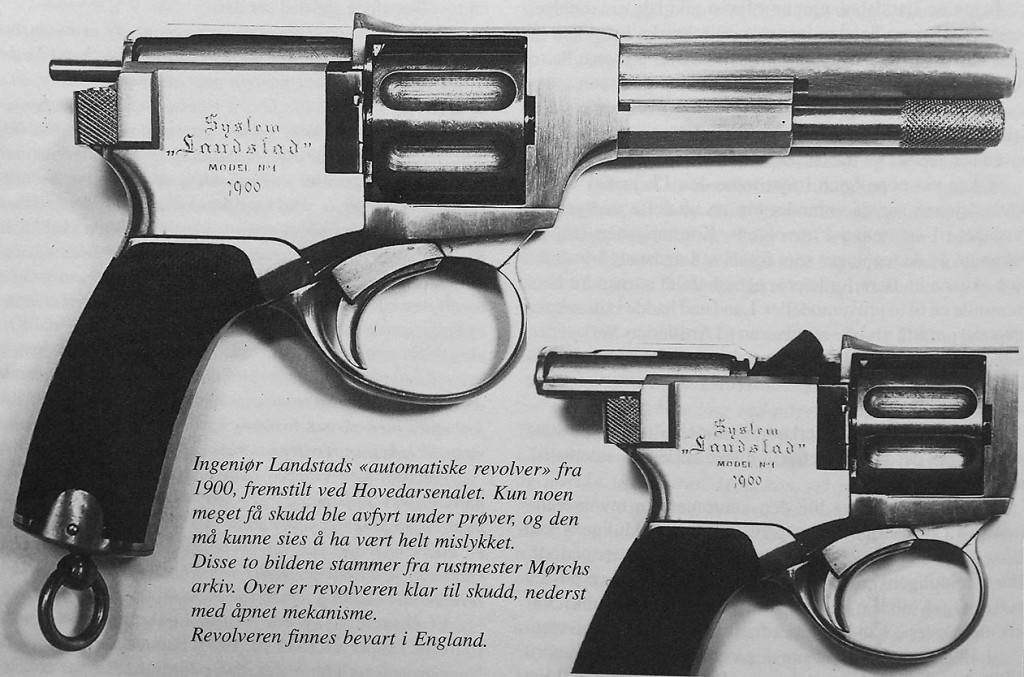
Bottom: Slide back, ejecting case
More unusually, the cylinder was actually flat, with only two chambers:
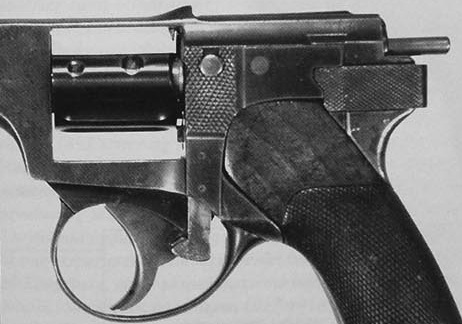
The firing cycle went like this: a round from the magazine would be loaded into the bottom chamber of the cylinder. Pulling the trigger would rotate the cylinder (like a DA revolver), moving the round up to the top, in line with the barrel. The hammer would fall, fire the round, and the recoil energy would cycle the slide assembly at the top rear, extracting and ejecting the empty case.
I’m unsure on a few points, like whether it could be fired single-action as well, and how the mechanism controlled loading of cartridges from the mag into the cylinder. Here are some photos of the Landstad disassembled:
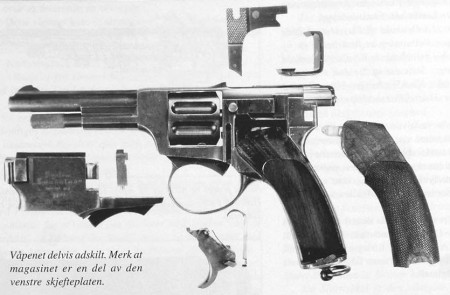
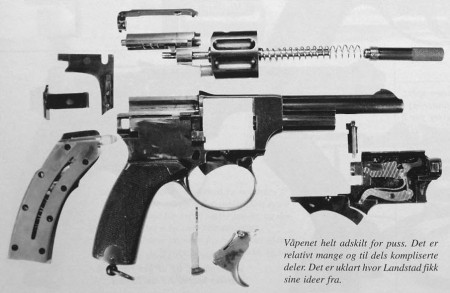
And here’s the one patent drawing I found:
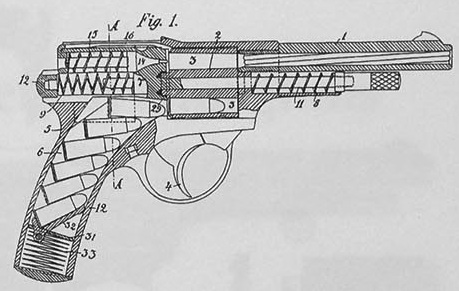
The gun never went into production, because of its dismal performance in trials. But it appears that the inventor kept the prototype gun, and brought it with him when he emigrated to the UK, living in Middlesex until his death in 1955. It was donated to the British NRA and kept in their museum at Bisley until 1977, when it was sold at auction.
The Landstad 1900 differs fundamentally from the more commonly known auto-revolvers like the Webley-Fosbery and Mateba in that it actually ejects cases when empty. The other guns are more accurately described as “self-cocking revolvers”, since they must be loaded and unloaded just like typical revolvers. Not a tremendously important distinction, but a valid one all the same.
Patents
Norgwegian Patent #8564 (Halvard Folkestad Landstad, “Automatisk revolver”, April 11, 1899)
German Patent 114,184 (Halvard Folkestad Landstad, “Selbstthatiger revolver”, August 1, 1899)
British Patent 22,479 (Halvard Folkestad Landstad, “Improvements in automatic revolvers”, January 13, 1900)

picture #1: Engineer Landstad’s “automatic revolver” from 1900, shown at the main arsenal. Only a few rounds where put through it during tests and the revolver was said to be a complete failure. The “automatic revolver” was anyway the first norwegian construction to be tried as an alternative for a future semi auto service pistol. The revolver is stored in England (Dr. Geoffry Sturgess collection and photography)
Picture #2: (the beginning of the text is basicly a summary of picture 1’s text however the ending has some additional description) These two pictures belong to armory master Mørch’s archive. Above the revolver is ready to fire, below with an open mechanism.
Picture #3: The weapon partially disassembled. The magazine is a part of the left grip.
Picture #4: Here the weapon is completely cleaned. There are relatively many and partially complicated parts. It is unclear where Langstad got his ideas from.
Think about what it would be like if it had a full eight shot cylinder and a six shot magazine? I say eight shot cylinder because of the projected diameter of a full cylinder.
Fourteen rounds when the rest had only seven or eight in full size guns and five or six in most pocket pistols?
Think Mauser Mk-213 in a pistol?
I am drawing concepts of a DA tube fed revolver, so far everything is working very simply, but i dont have a wa to eject shells from the cylinder. HELP WANTED! Reply if you want to put input in on the design.
using a slide mechanism an extractor and ejector that doubles as the striker could be fitted to the peice. In that when firing you load a cartridge into the chamber at the 6 o’clock position, while at the same time it would rotate upwards into the the next firing postion
Have you considered a ejector rod that cycles with the loading mechanism. Think of the tab that stuck out on the Henry rifle magazine tube. Not exactly that, but similar. It wouldn’t chase the follower but be fixed and each time a new round chambered it would trip a spring loaded rod that pushed the spent casing out a notch similar to the loading gate on single action revolvers to the right of the chamber that’s in battery. This is just a quick notion off the top of my head.
Halvard Folkestad Landstad also got German Patent 114184, valid from August, 1899 and published on October 16, 1900.It has 17 wonderful drawings, showing every aspect of the mechanism.
Thanks for pointing that out – I’ve added a couple patents to the article.
Like an M39 20mm cannon for your hand. Neat design.
I ended up building something similar that actually works, using a six-shot cylinder and direct gas to do shell ejection:
http://www.thefirearmblog.com/blog/2014/03/03/maurice-frankenruger-magazine-fed-revolver/
In my system the firing shell’s gas is used to eject the previously fired shell in the sequence. As soon as an empty cylinder chamber passes in from of the mag a new round is spring-injected into the back of the cylinder. The injection and ejection cycles aren’t really linked, in fact I tested the ejection cycle first when the critter was still a 357mag. To do the magazine I had to reduce the shell width so it’s now a 9mmPara.
It’s called Maurice because some people call it The Space Cowboy…has to be the weirdest carry piece in the US.
From the pics I can guarantee you the Landstad’s failure is on the ejection cycle. It has a narrow timing window in which mechanical ejection can happen. Gas is the answer – I had to install a brass pin into the side of the hammer as a shell deflector because unlike both the 38spl and even 357 tests the 9mm come outta there with some heat on it even in standard pressure, likely due to the tapered shells.
If the Landstad had used a full cylinder, gas based ejection and used the cylinder to increase capacity (but used the mags as is instead of my admittedly weird answer) it might have kicked ass :). The design could have been adapted to 9mmPara once that was available.
You can see the bottom of the slide has a little finger poking out which would slide backwards over the top of the round in the magazine, then catch it up on the way back forward and push it into the bottom chamber.
This weapon was almost definitely Double Action only.